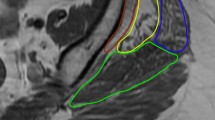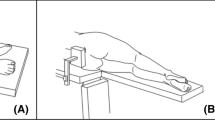Abstract
Purpose
To assess the functional and clinical outcomes of patients who underwent either open or endoscopic Whiteside transfer of gluteus maximus and tensor fascia lata muscles in cases of massive rupture of gluteus medius tendon associated with muscle atrophy on a native hip
Methods
This retrospective, descriptive, single-centre study was conducted by a single operator with a minimum follow-up period of 12 months. All Whiteside palliative transfers performed on patients with Type 5 gluteus medius tendon rupture, according to Lall’s classification, resulting in painful and treatment-resistant Trendeleburg gait between 2017 and 2022 were included. Functional evaluation was based on modified Harris Hip Scores (mHHS), iHOT-12, Non-Arthritic Hip Score (NAHS), and the pain on a Visual Analog Scale (VAS). Muscle strength was clinically assessed using the MRC classification.
Results
Between January 2017 and January 2022, a total of 15 Whiteside palliative transfers were identified, including nine (60%) open procedures and 6 (40%) endoscopic procedures, performed on 13 patients. One patient was excluded, and none were lost to follow-up. The median follow-up period was 41 (12; 59) months. The median age at the time of surgery was 74 (66; 76) years. The male-to-female sex ratio was 0.27. Functional results demonstrated a significant improvement in all scores: NAHS (45 vs. 72, p = 0.002), mHHS (22 vs. 55, p = 0.002), iHOT-12 (101 vs. 56, p = 0.002), and VAS (8 vs. 3, p = 0.002). Clinical outcomes also showed improvements in muscle strength (p = 0.003), single-leg stance (p = 0.01), and gait (p = 0.02). No significant differences were found in the various scores between the endoscopic and open techniques.
Conclusion
Whiteside transfer surgery, whether performed through open surgery or endoscopically, is a palliative surgical approach that should be considered for patients with irreparable gluteus medius tendon tears, where the main symptom is trochanteric pain. This procedure yields satisfactory clinical and functional outcomes, although the gains in abduction strength recovery and gait improvement are modest.



Similar content being viewed by others
References
Bunker TD, Esler CN, Leach WJ (1997) Rotator-cuff tear of the hip. J Bone Joint Surg Br 79:618–620
Kagan A (1998) Rotator-cuff tear of the hip. J Bone Joint Surg Br 80:182–183
Cormier G, Berthelot J-M, Maugars Y (2006) Gluteus tendon rupture is underrecognized by French orthopedic surgeons: results of a mail survey. J Bone Joint Surg Br 73:411–413
Coulomb R, Essig J, Mares O et al (2016) Clinical results of endoscopic treatment without repair for partial thickness gluteal tears. Orthop Traumatol Surg Res 102:391–395. https://doi.org/10.1016/j.otsr.2016.01.007
Lall AC, Schwarzman GR, Battaglia MR (2019) Greater trochanteric pain syndrome: an intraoperative endoscopic classification system with pearls to surgical techniques and rehabilitation protocols. Arthrosc Tech 8:e889–e903. https://doi.org/10.1016/j.eats.2019.04.004
Weber M, Berry DJ (1997) Abductor avulsion after primary total hip arthroplasty: results of repair. J Arthroplast 12:202–206
Lübbeke A, Kampfen S, Stern R, Hoffmeyer P (2008) Results of surgical repair of abductor avulsion after primary total hip arthroplasty. J Arthroplast 23:694–698
Thaunat M, Clowez G, Desseaux A et al (2018) Influence of muscle fatty degeneration on functional outcomes after endoscopic gluteus medius repair. Arthroscopy 34:1816–1824. https://doi.org/10.1016/j.arthro.2018.01.005
Whiteside LA (2014) Surgical technique: gluteus maximus and tensor fascia lata transfer for primary deficiency of the abductors of the hip. Clin Orthop Relat Res 472:645–653
Whiteside LA, Roy ME (2019) Incidence and treatment of abductor deficiency during total hip arthroplasty using the posterior approach: repair with direct suture technique and gluteus maximus flap transfer. Bone Joint J 101-B(6):116–122
Thaunat M, Roberts T, Bah A et al (2020) Endoscopic transfer of gluteus maximus and tensor fascia lata for primary hip abductor deficiency. Arthrosc Tech 9:e1235–e1239. https://doi.org/10.1016/j.eats.2020.04.024
Bauwens P-H, Haidar I, Thaunat M (2021) Endoscopic transfer of gluteus maximus and tensor fasciae latae for massive gluteus medius tear: preliminary results. Orthop Traumatol Surg Res 107. https://doi.org/10.1016/j.otsr.2021.102927
Chandrasekaran S, Darwish N, Vemula SP (2017) Outcomes of gluteus maximus and tensor fascia lata transfer for primary deficiency of the abductors of the hip. Hip Int 27:567–572. https://doi.org/10.5301/hipint.5000504
John J (1984) Grading of muscle power: comparison of MRC and analogue scales by physiotherapists. Medical Research Council. Int J Rehabil Res 7:173–181
Kumar P, Sen R, Aggarwal S (2019) Reliability of Modified Harris Hip Score as a tool for outcome evaluation of Total Hip Replacements in Indian population. J Clin Orthop Trauma 10:128–130
Christensen CP, Althausen PL, Mittleman MA et al (2003) The nonarthritic hip score: reliable and validated. Clin Orthop Relat Res:75–83. https://doi.org/10.1097/01.blo.0000043047.84315.4b
Dion M-O, Simonyan D, Faure P-A et al (2021) Validation of the French version of the Self-Administered International Hip Outcome Tool-12 Questionnaire and determination of the Minimal Clinically Important Difference (MCID) in the French speaking population. Orthop Traumatol Surg Res 107:103083. https://doi.org/10.1016/j.otsr.2021.103083
Perraton Z, Lawrenson P, Mosler AB et al (2022) Towards defining muscular regions of interest from axial magnetic resonance imaging with anatomical cross-reference: a scoping review of lateral hip musculature. BMC Musculoskelet Disord 23:533. https://doi.org/10.1186/s12891-022-05439-x
Goutallier D, Postel JM, Bernageau J, Lavau L, Voisin MC (1994) Fatty muscle degeneration in cuff ruptures. Pre- and postoperative evaluation by CT scan. Clin Orthop Relat Res (304):78–83
Fuchs B, Weishaupt D, Zanetti M (1999) Fatty degeneration of the muscles of the rotator cuff: assessment by computed tomography versus magnetic resonance imaging. J Shoulder Elb Surg 8:599–605
Christofilopoulos P, Kenanidis E, Bartolone P et al (2021) Gluteus maximus tendon transfer for chronic abductor insufficiency: the Geneva technique. Hip Int 31:751–758. https://doi.org/10.1177/1120700020924330
Whiteside LA (2012) Surgical technique: transfer of the anterior portion of the gluteus maximus muscle for abductor deficiency of the hip. Clin Orthop Relat Res 470:503–510. https://doi.org/10.1007/s11999-011-1975-y
Zügner R, Hjelmberg N, Rolfson O et al (2022) Gluteus maximus transfer following total hip arthroplasty does not improve abductor moment: a case-control gait analysis study of 15 patients with gluteus medius disruption. J Clin Med 11:3172. https://doi.org/10.3390/jcm11113172
Ruckenstuhl P, Wassilew GI, Müller M et al (2020) Functional assessment and patient-related outcomes after gluteus maximus flap transfer in patients with severe hip abductor deficiency. J Clin Med 9:1823. https://doi.org/10.3390/jcm9061823
Odak S, Ivory J (2013) Management of abductor mechanism deficiency following total hip replacement. Bone Joint J 95-B:343–347. https://doi.org/10.1302/0301-620X.95B3.31098
Bucher TA, Darcy P, Ebert JR et al (2014) Gluteal tendon repair augmented with a synthetic ligament: surgical technique and a case series. Hip Int 24:187–193. https://doi.org/10.5301/hipint.5000093
Browning RB, Clapp IM, Alter TD et al (2021) Superior gluteal reconstruction results in promising outcomes for massive abductor tendon tears. Arthrosc Sports Med Rehabil 3:e1321–e1327. https://doi.org/10.1016/j.asmr.2021.05.013
Thaunat M, Pacoret V, Saad M et al (2022) Endoscopic treatment of gluteus medius tendon tear. Orthop Traumatol Surg Res 108:103393. https://doi.org/10.1016/j.otsr.2022.103393
Randelli F, Mazzoleni MG, Fioruzzi A (2021) Surgical interventions for external snapping hip syndrome. Knee Surg Sports Traumatol Arthrosc 29:2386–2393. https://doi.org/10.1007/s00167-020-06305-w
Chandrasekaran S, Lodhia P, Gui C et al (2015) Outcomes of open versus endoscopic repair of abductor muscle tears of the hip: a systematic review. Arthroscopy 31:2057–2067.e2. https://doi.org/10.1016/j.arthro.2015.03.042
Longstaffe R, Dickerson P, Thigpen CA (2021) Both open and endoscopic gluteal tendon repairs lead to functional improvement with similar failure rates: a systematic review. J ISAKOS 6:28–34. https://doi.org/10.1136/jisakos-2020-000474
Author information
Authors and Affiliations
Contributions
1. Substantial contributions to the conception or design of the work; or the acquisition, analysis, or interpretation of data for the work; AND
2. Drafting the work or revising it critically for important intellectual content; AND
3. Final approval of the version to be published; AND
4. Agreement to be accountable for all aspects of the work in ensuring that questions related to the accuracy or integrity of any part of the work are appropriately investigated and resolved.
Adrien Portet: 1, 2, 3, 4
Pierre-Jean Lambrey: 1, 2, 3, 4
Rayanne Bennehedda: 1, 2, 3, 4
Luca Tanel: 1, 2, 3, 4
Paul-Henri Bauwens: 1, 2, 3, 4
Mathieu Thaunat: 1, 2, 3, 4
Corresponding author
Ethics declarations
Ethics approval
Référence Direction Recherche et Enseignement Ramsay Santé:COS-RGDS-2023-04-004-THAUNAT-M - RB00010835
Conflict of interest
Dr Mathieu Thaunat has a potential conflict of interest. Dr Thaunat is a consultant for Arthrex. The other authors declare they have no financial interests.
Informed consent
All patients gave valid consent to participate
Additional information
Publisher’s Note
Springer Nature remains neutral with regard to jurisdictional claims in published maps and institutional affiliations.
Level of Evidence: IV, case series with subgroup analysis
Investigation performed at Centre Orthopédique Santy, FIFA Medical Centre of Excellence, Groupe Ramsay-Générale de Santé, Hopital Privé Jean Mermoz, Lyon, France
Rights and permissions
Springer Nature or its licensor (e.g. a society or other partner) holds exclusive rights to this article under a publishing agreement with the author(s) or other rightsholder(s); author self-archiving of the accepted manuscript version of this article is solely governed by the terms of such publishing agreement and applicable law.
About this article
Cite this article
Portet, A., Lambrey, PJ., Benhenneda, R. et al. Short-term functional outcomes of Whiteside transfer for massive rupture of gluteus medius tendon in native hips. International Orthopaedics (SICOT) 48, 57–64 (2024). https://doi.org/10.1007/s00264-023-06050-y
Received:
Accepted:
Published:
Issue Date:
DOI: https://doi.org/10.1007/s00264-023-06050-y




